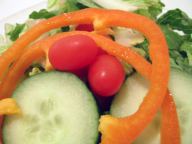So continuing on the trend of my previous post–Enjoy your food–but eat less!–I’d like to talk today about portion sizes. Yes, I know…not the most exciting topic–but I would guess that portion sizes are the number one reason why most people fail at their diets. People just don’t realize how much they eat!
Let’s take a look at my favorite diet and one of the most healthiest out there, The Dash Diet. The Dash Diet calls for:
- 6 oz. of meat a day
- 4- 5 servings of fruit a day
- 4- 5 servings of vegetables a day
- 6-8 servings of grains a day
- 2-3 servings of dairy a day
- 2-3 servings of fats and oils a day
- 4-5 servings of nuts, seeds, and legumes a week
- 5 or fewer servings of sweets per week
So what’s all this “servings” mean? Follow along at this wonderful website that helps you visualize portion sizes over at WebMD, located here. WebMD also offers a refrigerator size portion guide and a wallet-sized portion guide, as well! Let’s take a look at the first four items on the list and see!
6 ounces of meat a day
If you don’t think that sounds like much, you’re right! Take a look at any restaurant menu in the United States, and you’ll likely see steaks starting at 8 ounces and going up to 24 ounces! That’s four times your daily required meat in one sitting! Now…try to imagine what a 3 ounces piece of meat looks like on your plate. Did you imagine something about the size of a deck of cards, or the size of a typical smartphone?

Another idea to get you thinking about size is that most normal sized chicken breasts that you may get at a restaurant or at the store are about six ounces each (the double breast being 12 ounces–or more!). One chicken breast is all we need for the entire day. Think about this the next time you’re eating dinner. Most of us eat double to triple the amount of protein our bodies need per day, each meal.
4-5 servings of vegetables and 4-5 servings of fruit per day

Here’s where people suffer the opposite issue–not eating enough! Again, imagine your typical serving of vegetables when you eat (and to dispel a myth–corn is not a vegetable–it’s a grain!). Your vegetable serving should be the size of a baseball–or the size of your clenched fist. If that seems like a lot, again, it should be! And, our bodies need 4-5 of those servings PER DAY (of each fruits and vegetables!). The average Americans eat 1-2 servings of vegetables and 0-1 servings of fruit per day. If that’s you, your body definitely needs more!
6-8 servings of grains per day
Finally, let’s look at grains. Again, here’s where many people over estimate. A baseball or a  clenched fist is a good marker for a single serving most grains, such as cooked pasta, couscous, rice, corn, and popcorn. For pancakes, bread, or waffles–one slice/piece is typically one serving. Your sandwich? Two servings of grains. Your breakfast that includes a stack of four pancakes? Just the pancakes is half your grains for the day.
clenched fist is a good marker for a single serving most grains, such as cooked pasta, couscous, rice, corn, and popcorn. For pancakes, bread, or waffles–one slice/piece is typically one serving. Your sandwich? Two servings of grains. Your breakfast that includes a stack of four pancakes? Just the pancakes is half your grains for the day.
So what’s this all mean?
If you’re trying to trim down, look at not only what you’re eating, but how much! Use your fist as a guide for fruits and vegetables, and make sure you’re trying to get 5 servings each a day. Don’t worry if you miss your goal one day–or if you scarf down a 12 ounce steak when you didn’t mean to. Change takes time–and as long as you really want to eat better and you make the better choices more often than not–you’ll eventually be eating better without even knowing it!


 How many of us were taught to “clean your plate”, because there were starving children out there that would appreciate your dinner? Sadly, the idea of “cleaning your plate” can turn out to be a very unhealthy one. Instead, we should eat until we’re satisfied, and not eat anything else. However, if you have trouble doing that–trick yourself! Using a smaller plate or bowl for your meal will still give you the satisfaction of cleaning your plate, while not leading you to eat more than you need! For an interesting read on how the size of the container your food is in can affect how much you eat, read
How many of us were taught to “clean your plate”, because there were starving children out there that would appreciate your dinner? Sadly, the idea of “cleaning your plate” can turn out to be a very unhealthy one. Instead, we should eat until we’re satisfied, and not eat anything else. However, if you have trouble doing that–trick yourself! Using a smaller plate or bowl for your meal will still give you the satisfaction of cleaning your plate, while not leading you to eat more than you need! For an interesting read on how the size of the container your food is in can affect how much you eat, read 